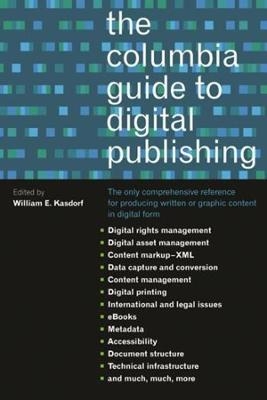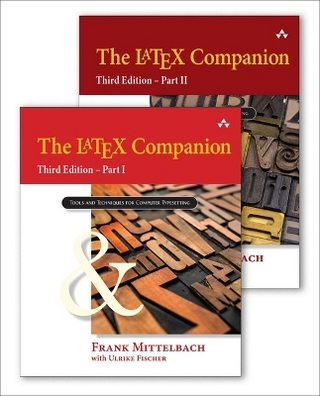
The Columbia Guide to Digital Publishing
Columbia University Press (Verlag)
978-0-231-12498-0 (ISBN)
What is metadata? When do you need to archive digital content? How does electronic publication affect copyrights? How can XML and PDF improve your workflow and your publications? There is a digital dimension to virtually all publishing today. Beyond the obvious electronic media-the music and movies we take for granted, the increasingly indispensable Web, the eBooks that most of us will take for granted in a few years-almost everything we read, even on paper, was produced digitally. This new digital world offers a steadily increasing number of choices. It is this rich and rapidly changing publishing environment for which The Columbia Guide to Digital Publishing was created. Although there is a vast amount of information on a host of topics relevant to digital production and publishing available-some in print, more on the Web-there has been, until now, no single resource to which those involved in any dimension of publishing could turn for guidance. The Columbia Guide to Digital Publishing fills that need. The Guide is definitive: written by experts in the broad array of subjects it covers, it provides reliable, authoritative, user-friendly information about a vast number of topics.
Designed to be the first place to go to learn about any of the numerous interrelated issues that define the digital publishing landscape, it offers readers a multilevel approach, from a brief glossary definition of a technical term or acronym (sometimes all a user needs), to a concise discussion of a topic (comprehensible to the lay person, yet useful for the technical expert). It puts a subject in the context of other topics and broader issues, with real-world examples, liberal cross-references, and pointers to sources of further information in print or electronic form.
William Kasdorf is president of Impressions Book and Journal Services and past-president of the Society for Scholarly Publishing. He is a frequent speaker at conferences across the country on various subjects related to digital publishing. He lives in Ann Arbor, MI.
1.Introduction: Publishing in Today's Digital Era, by William E. Kasdorf, President, Impressions Book and Journal Services, Inc. 1.01 Digital publishing is both a given and a goal 1.02 Various publishers, various solutions 1.03 What next? 2.The Technical Infrastructure, by Chris Biemesderfer, Seagoat Consulting 2.01 Overview 2.02 The basics of computer architecture 2.03 The processing environment 2.04 Display 2.05 Data storage 2.06 Data communications 2.07 Additional interesting resources 3.Markup: XML and Related Technologies, by William E.Kasdorf 3.01 Overview 3.02 HTML: HyperText Markup Language 3.03 XML: the Extensible Markup Language 3.04 Communication, cooperation, collaboration 4. Organizing, Editing, and Linking Content, by John Strange, Group Production Director, Blackwell Publishing 4.01 Overview: the transition from traditional to digital publishing 4.02 Structuring content 4.03 The impact of digital publishing on traditional publishing models 4.04 Information about content: metadata 4.05 Linking 4.06 Conclusion 5.Data Capture and Conversion, by Mark Gross, President, Data Conversion Laboratory 5.01 Overview: Entering a world of structure 5.02 Untangling content from structure 5.04 The conversion process 5.05 Analysis issues 6.Composition, Design, and Graphics, by Thad McIlroy, President, Arcadia House 6.01 Overview 6.02 Text, graphics, and page layout: The three elements of a page 6.03 Design vs. production 6.04 Three key technologies 6.05 PostScript: the language of print publishing 6.06 PDF -Adobe 's Portable Document Format 6.07 Typography 6.08 Graphic types and file formats 6.09 Color 6.10 Page production 6.11 Image capture and image processing 6.12 Work flow 6.13 Printing processes 6.14 Working with printers 6.15 Resources 7. Accessibility, by Frederick Bowes,III, Electronic Publishing Associates 7.01 Overview 7.02 A closer look 7.03 Closing summary 7.04 Resources and documents 8. Digital Printing, by George Alexander, Executive Editor, the Seybold Report 8.01 Overview 8.02 Digital printing technologies 8.03 Uses of digital printing 8.04 Available printing systems 8.05 Sales channels for digital book printing 9. Multimedia Publishing, by Florian Brody, President and CEO, Brody Inc. 9.01 Overview 9.02 What is multimedia? 9.03 Deciding on multimedia 9.04 Multimedia experience 9.05 The business of multimedia 9.06 Multimedia technology 9.07 Rights issues 9.08 Conclusion 10. Content Management and Web Publishing, by Bill Trippe, President, New Millennium Publishing and Mark Walter, Consultant 10.01 Introduction to content management 10.02 Types of Content Management Systems 10.03 Benefits of content management systems 10.04 Issues to consider in content management 10.05 Evaluating a content management system 10.06 Post-implementation issues 454 11.Electronic Books and the Open eBook Publication Structure, by Allen Renear, University of Illinois, Urbana-Champaign and Dorothea Salo 11.01 Introduction 11.02 OEBPS in a nutshell 11.03 Electronic books in general 11.04 Thinking clearly about e-books 11.05 The format problem 11.06 The OeBF Open eBook Publication Structure 11.07 In conclusion 11.08 Some advice for e-book publishers 11.09 For more information 12.Archiving, by Heather Malloy, Digital Archive Manager, John Wiley &Sons 12.01 The importance of archiving 12.02 Other concerns for archiving 12.03 Where to implement the archive 12.04 Technology issues 12.05 Issues in development and implementation 12.06 Conclusion 12.07 Resources 13.The Legal Framework: Copyright and Trademark, by William S.Strong, Partner, Kotin, Crabtree and Strong, LLP 13.01 Copyright 13.02 Trademark law 13.03 Other laws 13.04 Lawsuits: Is there nationwide jurisdiction? 13.05 Contracting with customers 13.06 Conclusion 14.International Issues, by Robert E.Baensch, Director, Center for Publishing, New York University 14.01 Overview 14.02 Internet users worldwide 14.03 The STM industry leaders 14.04 Establishing the Web Site 14.05 Understanding the global environment 14.06 Geographic and country priorities 14.07 English and other languages 14.08 New economics of information services 14.09 Worldwide on-line advertising 14.10 Marketing on the Internet 14.11 International information sources 14.12 Internet publishing law 14.13 Conclusion 15. Digital Rights Management, by Paul Hilts, Former Technology Editor, Publisher's Weekly 15.01 Overview: What is DRM? 15.02 Rights-based business models 15.03 DRM technology 15.04 DRM standards 15.05 Legal developments: important legislation 15.07 The state of the market 15.08 DRM Implementation Issues
| Erscheint lt. Verlag | 19.2.2003 |
|---|---|
| Verlagsort | New York |
| Sprache | englisch |
| Themenwelt | Schulbuch / Wörterbuch ► Lexikon / Chroniken |
| Informatik ► Grafik / Design ► Desktop Publishing / Typographie | |
| Sozialwissenschaften ► Kommunikation / Medien ► Buchhandel / Bibliothekswesen | |
| ISBN-10 | 0-231-12498-8 / 0231124988 |
| ISBN-13 | 978-0-231-12498-0 / 9780231124980 |
| Zustand | Neuware |
| Haben Sie eine Frage zum Produkt? |
aus dem Bereich


